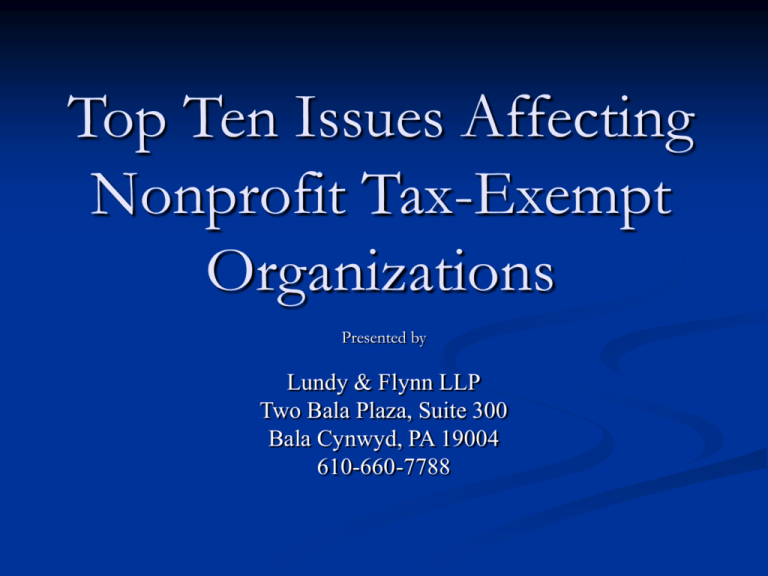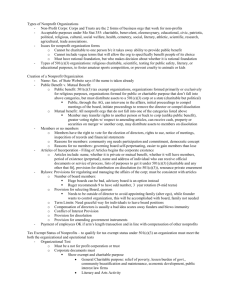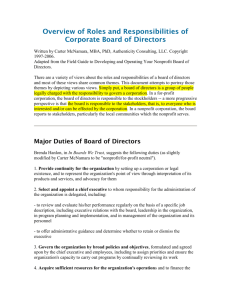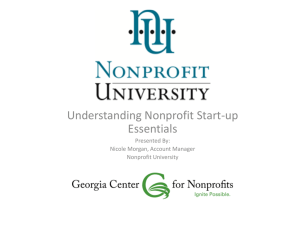Core Federal Charitable Exemption Requirements
advertisement

Top Ten Issues Affecting Nonprofit Tax-Exempt Organizations Presented by Lundy & Flynn LLP Two Bala Plaza, Suite 300 Bala Cynwyd, PA 19004 610-660-7788 Federal and State Law Concerns “Nonprofit” is state law concept Not “owned” by anyone – those who control the organization do not have an ownership interest in it Prohibition on paying dividends or profits to shareholders, members or other individuals Reasonable compensation can be paid but surpluses must stay within the organization and be used for the organization’s stated purposes “Tax-Exempt” is generally a federal law concept Section 501 of the Internal Revenue Code provides exemption from federal income tax for certain listed types of organizations Currently there are listed 27 separate categories of exempt organizations 501(c)(3) organizations (churches, hospitals, universities, charities) are just one type 1. Core Federal Charitable Exemption Requirements Public v. Private Foundation Status All 501(c)(3) organizations are either “public charities” or “private foundations” Under 509(a), organizations that are considered publicly supported (churches, hospitals, charities, etc.) are deemed “public charities” – those that are supported by a small group are deemed “private foundations” Public Charities generally deemed more favorable than private foundations 501(c)(3) public charities can receive deductible contributions (deductible up to 50% of AGI), issue tax-exempt bonds Private foundations can also receive deductible contributions (but only up to 30% of AGI) and are subject to more restrictive rules: have minimum distribution requirements; taxes on net investment income; restrictions on certain transactions with its board members, officers and other related persons Core Federal Charitable Exemption Requirements Qualification Under 501(c)(3) Requirements of 501(c)(3) status Must be organized and operated exclusively (primarily) for religious, charitable, educational or scientific purposes Promotion of health is a recognized charitable purpose Core Federal Charitable Exemption Requirements Organizational test -- satisfied by provisions in articles of incorporation (clear reference to the provisions of section 501(c)(3) or the regs to operative terms like “religious,” “charitable,” “scientific,” “educational,” etc. Articles should limit authority to engage only in activities furthering exempt purposes disclaim power to engage in substantial activities not in furtherance of exempt purposes Core Federal Charitable Exemption Requirements Operational test -- satisfied by showing that activities will: Be exclusively for charitable purposes (i.e., primarily activities that accomplish exempt purposes, and no more than an insubstantial part other than in furtherance of exempt purposes), Not permit net earnings to inure to the benefit of private shareholders or individuals (i.e., “insiders” -persons with personal and private interests in the organization’s activities and in a position to exercise influence over the organization’s affairs), Core Federal Charitable Exemption Requirements Not include participation in political campaigns Not consist of substantial lobbying, and Private inurement proscription buttressed by corollary private benefit limitation -- 501(c)(3) organization must serve a public interest rather than a private interest – i.e., must not be operated for the benefit or private interests Core Federal Charitable Exemption Requirements Private benefit limitation does not require participation of an “insider” Standard IRS formulation of private benefit test is that the benefit to private persons must be “qualitatively” and “quantitatively” incidental when compared to the benefit to the public To be “qualitatively” incidental, a benefit must be “a necessary concomitant of the activity which benefits the public at large” in the sense that “the benefit to the public cannot be achieved without necessarily benefiting certain private individuals” (e.g., the use of a hospital’s facilities by private practice physicians on active medical staff for treatment of their patients) To be “quantitatively” incidental, the benefit must be insubstantial in comparison with the benefit conferred upon the public 2. Fiduciary Issues for Nonprofit Boards of Directors Duty of Care 15 Pa.C.S.A. section 5712 Director as fiduciary – “Director shall perform his or her duties as a director . . . in good faith, in a manner the director reasonably believes to be in the best interests of the corporation and with such care, including reasonable inquiry, skill and diligence, as a person of ordinary prudence would use under similar circumstances Presumption: “Absent breach of fiduciary duty, lack of good faith, or self-dealing, any act as the board of directors, a committee of the board, or an individual director shall be presumed to be in the best interests of the corporation Fiduciary Issues for Nonprofit Boards of Directors If a bylaw of the organization so provides, a director shall not be personally liable for monetary damages for any action taken or any failure to take any action as a director unless: 1. 2. The director breached or failed to perform the duties of his or her office; and The breach or failure constitutes self-dealing, willful misconduct or recklessness. This does not apply to the responsibility of a director pursuant to any criminal statute or the liability of a director for the payment of taxes Fiduciary Issues for Nonprofit Boards of Directors Bylaw Provisions for Nonprofit Corporations Directors Statute requires at least one director If the Bylaws do not fix a certain number, statute mandates that there be three If no term of office stated, it is fixed by law at one year If no mechanism for filling vacancies is specified, vacancies are filled by a majority vote of (remaining) directors (even if less than a quorum) Fiduciary Issues for Nonprofit Boards of Directors Unless Bylaws provide otherwise, each director is entitled by law to one vote Meetings Statute provides that there must be an annual meeting of directors for the election of directors and officers, appointment of Standing Committees, and the transaction of any other business which may be brought before the meeting Unless Bylaws provide otherwise, regular meetings are held at such place and time as shall be designated by resolution of the Board Special meetings may be called by the Chair, the President, or any two directors upon five days notice Fiduciary Issues for Nonprofit Boards of Directors Quorum Unless the Bylaws provide otherwise, a majority of directors shall constitute a quorum for the transaction of business. The acts of a majority of the directors present and voting at a meeting at which a quorum is present shall be the acts of the Board Officers The statute requires at a minimum, a President, a Treasurer and a Secretary Unless the Bylaws provide otherwise, officers are reelected annually Fiduciary Issues for Nonprofit Boards of Directors Conflicts of Interest By statute, transactions between a nonprofit organization and its officers and directors (or organizations in which the officers or directors are involved) are not void if all material facts concerning the relationship are made known to the Board and the transaction is deemed fair to the nonprofit organization at the time it is authorized. Having a Conflicts of Interest Policy is considered a “best practice” Fiduciary Issues for Nonprofit Boards of Directors Annual Report The statute requires the President and Treasurer to present to the Board at its annual meeting a report, verified by the President and Treasurer or by a majority of the Board, showing in appropriate detail the following for the immediately preceding year: The corporation’s year end assets and liabilities The principal changes in assets and liabilities The revenue or receipts of the Corporation The expenses or disbursements of the Corporation Fiduciary Issues for Nonprofit Boards of Directors Indemnification A nonprofit corporation may indemnify any representative who was or is a party or is threatened to be made a party to any threatened, pending or completed action or proceeding, by reason of the fact that he or she is or was a representative of the Corporation, against expenses (including attorneys’ fees), judgments, fines, and amounts paid in settlement actually and reasonably incurred The corporation may limit the indemnification by providing that it applies only if the representative acted in good faith Fiduciary Issues for Nonprofit Boards of Directors Volunteer Protection Statutes The Volunteer Protection Act of 1997, 42 U.S.C.A. § § 14501-14505 (1997) VPA is intended to promote volunteerism by giving protection from liability to volunteers who serve nonprofit organizations Fiduciary Issues for Nonprofit Boards of Directors A volunteer is not liable for his/her actions if : 1. 2. 3. 4. Volunteer was acting within scope of his/her responsibility If required by law, the volunteer was licensed or authorized by the appropriate authorities for the activities or practice from which the harm resulted The harm was not caused by “willful or criminal misconduct, gross negligence, reckless misconduct, or a conscious, flagrant indifference to the rights or safety of the individual harmed by the volunteer; and The harm was not caused by the volunteer operating a vehicle for which applicable state law requires an operator to possess an operator’s license or to maintain insurance. Fiduciary Issues for Nonprofit Boards of Directors A volunteer will not be shielded from liability if his/her misconduct: 1. 2. 3. 4. 5. Constitutes a crime of violence or an act of international terrorism for which the volunteer has been convicted Constitutes a hate crime under state law Involves a sexual offence, as defined under applicable state law, for which the volunteer has been convicted Involves actions for which the volunteer has been found to have violated federal or state civil rights law; or Occurred at a time when the volunteer was under the influence of drugs or alcohol Fiduciary Issues for Nonprofit Boards of Directors Pennsylvania’s “Good Samaritan” Laws 42 Pa.C.S. § 8332.2 Officer, Director or Trustee of Nonprofit Organization Negligence Standard: “No person who serves without compensation, other than reimbursement for actual expenses, as an officer, director or trustee of any nonprofit organization under section 501(c)(3) of the [IRC] shall be liable for any civil damages as a result of any acts or omissions relating solely to the performance of his or her duties as an officer, director, or trustee, unless the conduct of the person falls substantially below the standards generally practiced and accepted in like circumstances by similar persons performing the same or similar duties, and unless it is shown that the person did an act or omitted the doing of an act which the person was under a recognized duty to another to do, knowing or having reason to know that the act or omission created a substantial risk of actual harm to the person or property. It shall be insufficient to impose liability to establish only that the conduct of the person fell below ordinary standards of care. Fiduciary Issues for Nonprofit Boards of Directors Director & Officer Liability Insurance Volunteer protection statutes provide volunteers with a defense in the event they are sued Even though a volunteer may have a viable defense, D&O liability insurance helps to cover the costs of mounting such a defense D&O insurance can be helpful to attract new board members 3. Annual Information Reporting Requirements New Reporting Requirements Tax-exempt organizations whose “gross receipts” are “normally $25,000 or less” are not required to file Annual Information Return - “Form 990” New for 2008 – For tax years ending after 12/31/07, such organizations are required to electronically submit “Form 990-N,” known as the “e-Postcard” Due by the 15th day of the 5th month after close of tax year Include: EIN, name, address, name & address of principal officer, etc. Visit http://www.irs.gov/charities/article/0,,id=169250,00.html to complete and file the e-Postcard For 2010 tax year, filing threshold increased to $50,000 Annual Information Reporting Requirements No significant changes to 2007 Form 990 from 2006 A redesigned Form 990 has been introduced for tax years ending on or after 12/31/08 (e.g., if your tax year ends on 12/31/09, the new Form 990 is due to be filed by 5/15/09 unless an extension is granted) The redesigned form consist of a “core” and a series of schedules 4. Charitable Fundraising Charitable Solicitation Registration Fundraising in PA regulated by the Solicitation of Funds for Charitable Purposes Act 10 P.S. § 162.2 et seq. Requires registration of charitable organizations, professional fundraisers and professional solicitors Penalties for noncompliance include fines (up to $1,000 for each act and up to $100/day during which violation continues); revocation or suspension of registration; cease & desist orders Charitable Fundraising Charitable Solicitation Registration Must submit application form (Form BCO-10) within 30 days of receiving $25,000 in gross national contributions or prior to compensating anyone to solicit contributions from Pennsylvania residents Must file with the application a copy of IRS Form 990 and appropriate financial statements for the most recently completed fiscal year Charitable Fundraising Internet Fundraising Charleston Principles developed by NASCO Advisory only! Out-of-state websites not required to register if they only passively solicit donations and do not affirmatively target residents of a particular state If, after receiving an out-of-state “passive” donation, the charity solicits that donor for another donation, the charity must register in the donor’s state Charitable Fundraising Acknowledging Charitable Contributions Donor must have bank record or written communication from charity to claim charitable contribution deduction Donor is responsible for obtaining written acknowledgment from charity for any single contribution of $250 or more Payroll Deductions – When donor makes single payment of $250 or more by payroll, donor can use either: (i) pay stub, W-2, etc; or (ii) a pledge card that includes statement that organization does not provide goods or services for contributions by payroll Charitable Contributions Charitable organization must provide written disclosure to donor who receives goods and services in exchange for single payment greater than $75 (quid pro quo contribution) Donor can only take deduction to extent contribution exceeds FMV of goods and services received Written disclosure not required where goods or services meet “token exception,” “membership benefits exception” or “intangible religious exception” Charitable Contributions Token Exception the fair market value of the benefits received does not exceed the lesser of 2 percent of the payment or $89, or the payment is at least $44.50, the only items provided bear the organization’s name or logo (e.g., calendars, mugs, or posters), and the cost of these items is within the limit for “low-cost articles,” which is $8.90 Charitable Contributions Membership Benefits Exception An annual membership benefit is also considered to be insubstantial if it is provided in exchange for an annual payment of $75 or less and consists of annual recurring rights or privileges, such as: free or discounted admissions to the charitable organization’s facilities or events discounts on purchases from the organization’s gift shop free or discounted parking free or discounted admission to member-only events sponsored by an organization, where a per-person cost (not including overhead) is within the “low-cost articles” limits Charitable Contributions Intangible Religious Benefit Exception If a religious organization provides only “intangible religious benefits” to a contributor, the acknowledgment does not need to describe or value those benefits. It can simply state that the organization provided intangible religious benefits to the contributor. “Intangible Religious Benefits” are benefits provided by a taxexempt organization operated exclusively for religious purposes, and are not usually sold in commercial transactions outside a donative (gift) context (e.g., admission to religious ceremony). 5. Purely Public Charity Status To qualify as an “Institution of Purely Public Charity” a charity must: Advance a charitable purpose; Operate entirely free from private profit motive; Donate or render gratuitously a substantial portion of its services; Benefit a substantial and indefinite class of persons who are legitimate subjects of charity; Relieve the government of some of its burden Purely Public Charity Status Benefits of being a Purely Public Charity Can obtain a sales tax exemption from the PA Dept. of Revenue for purchases made by the charitable organization Can obtain an exemption from real estate taxes (from the local authority) for property owned and used by the charitable organization for charitable purposes 6. Corporate Governance Issues IRS Best Practices – Recommends adoption of some or all of the following Mission Statement Code of Ethics Due Diligence Duty of Loyalty Transparency Fundraising Policy Financial Audits Compensation Practices Document Retention Policy 7. Lobbying No substantial part of the activities of 501(c)(3) public charity may be carrying on propaganda or attempting to influence legislation (except as provided in 501(h)) “No substantial part” not defined 5% considered safe (although IRS not bound by a specific percentage and method for measuring activities unclear) Private foundations not permitted any lobbying activity Lobbying IRC § 501(h) permits organizations to elect an objective standard to measure lobbying activities Once the election is in effect, an organization can spend the following amounts (up to an annual maximum of $1 million) on lobbying activities: (i) 20% of the first $500,000 of the organization's annual charitable purpose expenditures; (ii) 15% of the next $500,000; (iii) 10% of the next $500,000; and (iv) 5% thereafter This limitation is further subdivided so that only 25% of the basic limit may be spent for "grass roots lobbying" (i.e., any attempt to influence legislation through an attempt to affect the opinion of the general public or any segment thereof) Amounts spent in excess of the permitted lobbying or grassroots expenditures are subject to a 25% excise tax File Form 5768 to elect under IRC 501(h) Lobbying Safe Harbors An electing organization will not be treated as influencing legislation if it: Makes available the results of nonpartisan analysis, study or research Provides technical advice or assistance at the request of the government Testifies or communicates about legislation that would affect the organization’s existence, powers, duties, or tax-exempt status, or the deductibility of contributions; Communicates with its members (only) about specific legislation of direct interest to the organization, but without urging them to lobby or to urge others to lobby; or Communicates with government employees on non-legislative matters and without any purpose to influence legislation 8. Political Intervention All IRC 501(c)(3) organizations are prohibited from directly or indirectly participating in, or intervening in, any political campaign on behalf of, or in opposition to any candidate for elective office Violation may lead to revocation of tax-exempt status and imposition of certain excise taxes Political campaign intervention includes any and all activities that favor or oppose one or more candidates for public office. 501(c)(3) organizations are permitted to engage in certain voter education activities if carried out in a nonpartisan manner 9. Unrelated Business Income Unrelated Business Income (IRC §§ 511-515) A tax on the net income of trade or business regularly carried on, and not substantially related to exempt purposes other than through the production of income, subject to modifications, exceptions, and exclusions Key modifications include Dividends, interest, royalties, certain rents and capital gains However, above items are included in the case of debt-financed property (although schools, qualified pensions and similar organizations may, under certain circumstances, exclude rents from debt-financed property) 10. Joint Ventures Reasons for Joint Ventures Increasing capital needs Reduced reimbursements/payments Technological advances Expansion refurbishment of physical facilities Preferable to borrowing (lower cost of capital – reaching creditor limits) Joint Ventures Nature of problematic transactions Tax-exempt organizations in joint ventures/partnerships with private, for-profit or taxable, business organizations Organization serving as general partner in a partnership or managing member of a limited liability company (“LLC”) The organization’s participation must further its exempt purposes, and The partnership must not prevent the organization from acting in furtherance of its exempt purposes and cannot result in inurement to insiders or more than incidental private benefit to the for-profit partners Limited partner status typically only raises UBI issues Joint Ventures If exempt organization enters into an “ancillary” joint venture that is related to the organization’s exempt purposes, the partner’s distributive share of income usually treated as exempt function income If exempt organization enters into an “ancillary” joint venture that is unrelated to the organization’s exempt purposes, the partner’s distributive share of income usually treated as unrelated trade or business income If unrelated trade or business were substantial enough, it could jeopardize 501(c)(3) status because it would be evidence of substantial non-exempt purpose






